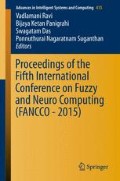Abstract
Centrality measures are extremely important in the analysis of social networks, with applications such as identification of the most influential individuals for effective target marketing. Eigenvector centrality and PageRank are among the most useful centrality measures, but computing these measures can be prohibitively expensive for large social networks. This paper shows that neural networks can be effective in learning and estimating the ordering of vertices in a social network based on these measures, requiring far less computational effort, and proving to be faster than early termination of the power grid method that can be used for computing the centrality measures. Two features describing the size of the social network and two vertex-specific attributes sufficed as inputs to the neural networks, requiring very few hidden neurons.
Access this chapter
Tax calculation will be finalised at checkout
Purchases are for personal use only
Notes
- 1.
All the results reported in this paper were from simulations executed on an Intel Corei5@2.60 GHz machine with 8 GB RAM.
- 2.
Random network generation algorithms were obtained from [5, 16], and scale-free network generating algorithms were from [6, 15], using the implementation in the Python software package, NetworkX (http://networkx.github.io).
References
Newman, M.: Networks: An Introduction. Oxford University Press, Oxford (2010)
Bonacich, P.: Factoring and weighting approaches to status scores and clique identification. J. Math. Sociol. 2(1), 113–120 (1972)
Page, L., Brin, S., Motwani, R., Winograd, T.: The pagerank citation ranking: bringing order to the web (1999)
Lanczos, C.: An Iteration Method for the Solution of the Eigenvalue Problem of Linear Differential and Integral Operators. Press Office, United States Governm (1950)
Erdös, P., Rényi, A.: On the evolution of random graphs. Publ. Math. Inst. Hung. Acad. Sci. 5, 17–61 (1960)
Barabási, A.-L., Albert, R.: Emergence of scaling in random networks. Science 286(5439), 509–512 (1999)
Clauset, A., Shalizi, C.R., Newman, M.E.J.: Power-law distributions in empirical data. SIAM Rev. 51(4), 661–703 (2009)
Faloutsos, M., Faloutsos, P., Faloutsos, C.: On power-law relationships of the internet topology. In: ACM SIGCOMM Computer Communication Review, vol 29, pp. 251–262. ACM (1999)
Degree distribution of scale free and random network. https://en.wikipedia.org/wiki/Scale-free_network
Books about us politics. http://networkdata.ics.uci.edu/data.php?d=polbooks
Girvan, M., Newman, M.E.J.: Community structure in social and biological networks. Proc. Natl. Acad. Sci. 99(12), 7821–7826 (2002)
Lusseau, D., Schneider, K., Boisseau, O.J., Haase, P., Slooten, E., Dawson, S.M.: The bottlenose dolphin community of doubtful sound features a large proportion of long-lasting associations. Behav. Ecol. Sociobiol. 54(4), 396–405 (2003)
Newman, M.E.J.: Finding community structure in networks using the eigenvectors of matrices. Phys. Rev. E 74(3), 036104 (2006)
Zachary, W.W.: An information flow model for conflict and fission in small groups. J. Anthropol. Res. 33, 452–473 (1977)
Holme, P., Kim, B.J.: Growing scale-free networks with tunable clustering. Phys. Rev. E 65(2), 026107 (2002)
Batagelj, V., Brandes, U.: Efficient generation of large random networks. Phys. Rev. E 71(3), 036113 (2005)
Author information
Authors and Affiliations
Corresponding author
Editor information
Editors and Affiliations
Rights and permissions
Copyright information
© 2015 Springer International Publishing Switzerland
About this paper
Cite this paper
Kumar, A., Mehrotra, K.G., Mohan, C.K. (2015). Neural Networks for Fast Estimation of Social Network Centrality Measures. In: Ravi, V., Panigrahi, B., Das, S., Suganthan, P. (eds) Proceedings of the Fifth International Conference on Fuzzy and Neuro Computing (FANCCO - 2015). Advances in Intelligent Systems and Computing, vol 415. Springer, Cham. https://doi.org/10.1007/978-3-319-27212-2_14
Download citation
DOI: https://doi.org/10.1007/978-3-319-27212-2_14
Published:
Publisher Name: Springer, Cham
Print ISBN: 978-3-319-27211-5
Online ISBN: 978-3-319-27212-2
eBook Packages: Computer ScienceComputer Science (R0)

